|
|
NOTES
This publication was reissued on 8/3/06 after an error was discovered in the Total Proportion of Businesses Innovating figure for Australia in the international comparisons table.
INTRODUCTION
This publication presents the results of the third Innovation survey conducted by the Australian Bureau of Statistics (ABS). The 1993-94 survey covered a range of industry sectors. A more detailed survey was conducted in respect of 1996-97 but only covered Manufacturing and Mining industries. The 2003 survey was broader in scope and covers businesses in all ANZSIC divisions with the exception of Agriculture, forestry and fishing; Government administration and defence; Education; Health and community services and Personal and other services divisions. It also excluded businesses with less than five employees and those classified to General Government in the Standard Institutional Sector Classification of Australia (SISCA).
The 2003 survey collected details of innovation and expenditure. It was based on concepts and standard questions developed jointly by the Organisation for Economic Co-operation and Development (OECD) and Eurostat. The concepts have been published in 'OECD Proposed Guidelines for Collecting and Interpreting Technological Innovation Data' (OECD, Paris, 1997), known as the Oslo Manual.
The survey was largely consistent with international frameworks outlined in the Oslo Manual and will provide comparability with several international surveys, most notably the Eurostat Community Innovation Surveys. The central aspect of the Oslo Manual, and most innovation surveys conducted internationally, has been the measurement of technological innovation. While technological innovation has been one of the key drivers of economic growth over the past few decades, there is a growing realisation that non-technological innovation may also contribute significantly. The Oslo Manual is now being revised to take this into account. For the Innovation Survey 2003, the ABS went beyond current guidelines to separately identify non-technological innovation.
DEFINING INNOVATION
For the purposes of this collection the ABS has defined the term innovation as the process of introducing new or significantly improved goods or services and/or implementing new or significantly improved processes. New goods or services or new processes may involve the development of new technology, an adaptation of existing technology to a new use (e.g. electronic commerce), or may be non-technological in nature (e.g organisational and managerial change, some changes in marketing). Innovation has been classified into three categories. These categories are defined as:
- A new good or service means any good or service or combination of these which is new to a business. Its characteristics or intended uses differ significantly from those previously produced.
- A new operational process is a significant change for a business in its methods of producing or delivering goods or services.
- A new organisational/managerial process is a significant change to the strategies, structures or routines of the business which aim to improve performance.
INQUIRIES
For further information about these and related statistics, contact the National Information and Referral Service on 1300 135 070 or Peter Hodgson on Perth (08) 9360 5367.
INTRODUCTION
Innovation, both technological and non-technological, is seen as a key driver of economic growth. Innovation in business is characterised by the introduction of new or significantly improved goods or services and/or the implementation of new or significantly improved processes (which includes operational and organisational/managerial processes).
BUSINESSES THAT INNOVATED
During the three years ended December 2003 innovation was undertaken by 34.8% of businesses. A higher proportion of businesses innovating (22.9%) implemented new or significantly improved operational processes than introduced new or significantly improved goods or services (16.6%).
Business size
The extent of innovation varied according to the employment size of the business, ranging from 30.4% for businesses with 5-19 persons, up to 60.8% for businesses with 100 or more persons. For businesses with 5-19 persons and those with 100 or more persons, the most common form of innovation was the implementation of new or significantly improved operational processes. For businesses with 20-99 persons it was the implementation of new or significantly improved organisational/managerial processes.
PROPORTION OF BUSINESSES INNOVATING, 2001-2003, Types of innovation undertaken, by employment size
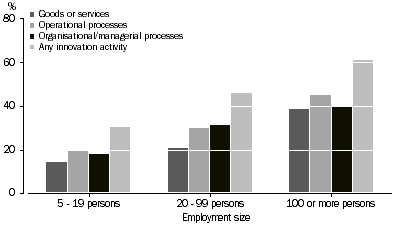
When comparing proportions of innovation by business income size range, the proportion of businesses innovating increases as income increases.
PROPORTION OF BUSINESSES INNOVATING, 2001-2003, Types of innovation undertaken, by income size
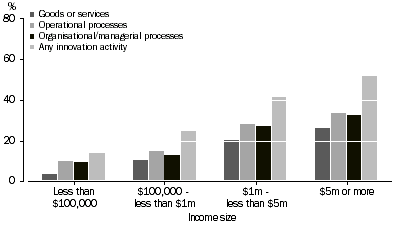
State/Territory/Region
Innovation was classified to the state or territory of the head office for businesses with operations in more than one state or territory. The majority of innovating businesses were in New South Wales and Victoria, but South Australia had the highest proportion of businesses undertaking innovation (45.9%). The proportions of businesses innovating in New South Wales, Victoria, Queensland and Western Australia were similar at around 30-35%. In Tasmania, Northern Territory and the Australian Capital Territory the proportion of businesses innovating was lower.
South Australia had the highest proportion of businesses which innovated under all three types of innovation. New South Wales, Victoria, Queensland, Western Australia and the Australian Capital Territory had similar proportions of businesses which implemented new or significantly improved operational processes and organisational/managerial processes (ranging between 20.6% and 23.0%). After South Australia, with 23.8% of businesses, New South Wales (17.8%) and Victoria (17.1%) had the next highest proportions of those introducing new or significantly improved goods or services.
There was little difference in the level of innovation reported between those businesses located in Capital cities and those in other areas.
PROPORTION OF BUSINESSES INNOVATING, 2001-2003, by states and territories
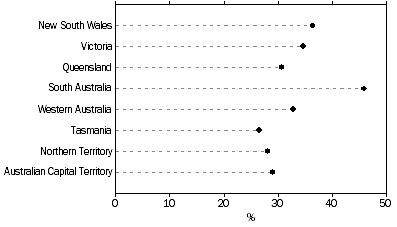
Industry
Just over half of the businesses in the Communication services (51.1%) and Electricity, gas and water supply (50.8%) industries undertook innovation. Businesses in the Accommodation, cafes and restaurants (26.5%) and Construction industries (30.7%) had the lowest proportion of businesses innovating.
PROPORTION OF BUSINESSES INNOVATING, 2001-2003, by industry
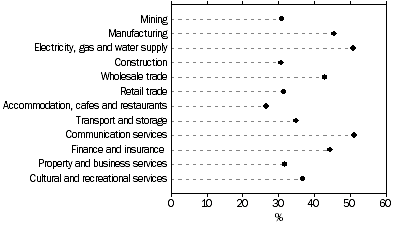
Main characteristics
The characteristics of innovating businesses are presented in detail in subsequent chapters. The main characteristics most frequently reported by innovating businesses are:
- More innovating businesses (62.3%) reported that cost related barriers hampered their innovation than any other barriers.
- Profit related drivers were selected by more innovating businesses as the key reasons they developed new goods or services (71.4%) or new operational processes (71.5%).
- 27.0% of innovating businesses were involved in collaborative activities, mostly collaborating with suppliers, clients, competitors or consultants (25.1%).
- The majority of innovating businesses reported sourcing ideas or information internally to develop new goods or services or new processes (87.7%). Some 39.9% of innovating businesses reported that employing new skilled staff was the main method used to acquire knowledge or abilities to introduce these goods, services and processes.
- General business skills were sought by 31.6% of innovating businesses to develop, introduce or implement new goods or services, and by 29.4% for new processes.
- Formal methods were used by 21.5% of innovating businesses to protect intellectual property, while informal methods were used by 36.6%.
EXPENDITURE ON INNOVATION AND RELATED ACTIVITIES
Total expenditure on innovation and related activities includes expenditure on research and experimental development. Total expenditure by all businesses on innovation and related activities in 2002-03 was $20,296.6 million, which is a gross estimate that includes acquired research and development expenditure. This was 1.7% of total business expenditure. Innovating businesses spent $18,923.9 million on innovation and related activities which was 2.4% of their total expenditure.
EXPENDITURE ON INNOVATION AND RELATED ACTIVITIES, 2002-03(a)(b) |
|  |
 | Innovating businesses
| All businesses
|  |
 | Expenditure | Proportion of total expenditure | Expenditure | Proportion of total expenditure |  |
 | $m | % | $m | % |  |
|  |
Expenditure on research and
experimental development(c)(d) | 5,800.6 | 0.7 | 7,167.0 | 0.6 |  |
| Expenditure on innovation | ^13,123.4 | ^1.7 | ^13,129.6 | ^1.1 |  |
Total expenditure on innovation
and related activities(d) | ^18,923.9 | ^2.4 | ^20,296.6 | ^1.7 |  |
|  |
| ^ estimate has a relative standard error of 10% to less than 25% and should be used with caution |
| (a) Expenditure estimates should be used with care, see Technical Notes for more detail. |
| (b) Data relates to the most recent financial year ended on or before 30 September 2003. |
| (c) See Explanatory Notes paragraph 19 on comparisons with the Research and Experimental Development collection. |
| (d) Includes $914.2 million of expenditure on acquired research and experimental development by innovating businesses and $1017.8 million by all businesses. |
EXPENDITURE ON INNOVATION BY INNOVATING BUSINESSES
Total expenditure on innovation in 2002-03 by innovating businesses was $13,123.4 million. Innovating businesses in Victoria contributed 35.7% to the total expenditure on innovation even though they comprised 25.5% of innovating businesses in Australia. New South Wales was the next highest contributor to the total expenditure on innovation with 34.8%. Apart from Victoria, South Australia was the only other state or territory to contribute more to the total Australian expenditure on innovation (11.0%) than they contributed to the total number of innovative businesses in Australia (8.5%).
CONTRIBUTION TO EXPENDITURE ON INNOVATION (a), 2002-03, by states and territories
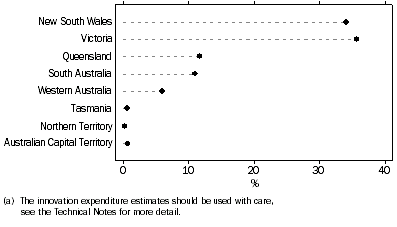
The Manufacturing industry contributed the highest proportion (27.1%) to the total Australian expenditure on innovation. Industries where the proportion of total expenditure on innovation was more than double that industry's proportion of total Australian innovating businesses were the Mining, Electricity, gas and water supply, Communication services and Finance and insurance industries.
CONTRIBUTION TO EXPENDITURE ON INNOVATION (a), 2002-03, by industry
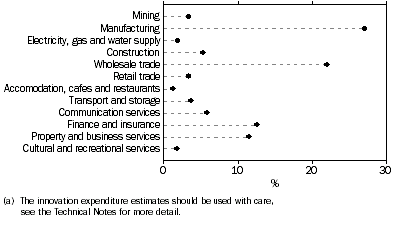
HISTORICAL COMPARISON
Manufacturing industry
Data from the 1993-94 and 1996-97 Innovation in Manufacturing surveys are compared to the 2003 Innovation survey data below. The data from 2003 exclude the implementation of new or significantly improved organisational/managerial processes as this information was not collected in the earlier surveys. See paragraph 13 of the Explanatory Notes for more detail on data comparability.
Overall, the proportion of businesses innovating in the Manufacturing industry decreased slightly from 41.7% in 1991-94 to 39.5% in 2001-03, though the proportion in 2003 was higher than 1994-97 (36.4%). The Wood and paper products industry had the most noticeable change in the proportion of businesses innovating increasing from 18.6% in 1991-94 to 35.8% in 2001-03. The largest decrease was in the Non-metallic mineral products industry, which dropped from 44.5% in 1991-94 to 31.0% in 2001-03. Petroleum, coal, chemical and associated products industry has maintained a high proportion of businesses innovating during the three time periods, only decreasing slightly from 55.0% in 1991-94 to 51.4% in 2001-03.
MANUFACTURING INDUSTRY, 1991-94, 1994-97 and 2001-03, Proportion of businesses innovating(a)(b) |
|  |
 | 1991-94 | 1994-97 | 2001-3 |  |
 | % | % | % |  |
|  |
| Food, beverages and tobacco | 42.6 | 34.4 | 36.7 |  |
| Textiles, clothing, footwear and leather | 36.2 | 34.8 | 30.7 |  |
| Wood and paper products | 18.6 | 16.6 | 35.8 |  |
| Printing, publishing and recorded media | 42.8 | 34.8 | 44.6 |  |
| Petroleum, coal, chemical and associated products | 55.0 | 53.3 | 51.4 |  |
| Non-metallic mineral products | 44.5 | 42.7 | 31.0 |  |
| Metal products | 39.4 | 30.5 | 34.9 |  |
| Machinery and equipment | 55.0 | 44.1 | 48.3 |  |
| Other manufacturing | 35.1 | 38.8 | 28.9 |  |
| Total manufacturing | 41.7 | 36.4 | 39.5 |  |
|  |
| (a) Data from 2001-03 excludes the implementation of new or significantly improved organisational/managerial processes. |
| (b) Data from 1991-94 and 1994-97 are in respect of financial years whereas 2001-03 is in respect of calendar years. |
There was a decrease in the proportion of businesses innovating that introduced new or significantly improved goods or services, from 36.8% in 1991-94 down to 27.1% in 2001-03. The Wood and paper products was the only industry that increased over this time period, up from 15.5% in 1991-94 to 19.3% in 2001-03. Over the same time period there were noticeable decreases in the proportion of businesses innovating in both Non-metallic mineral products (down from 42.0% to 20.9%) and Petroleum, coal, chemical and associated products (down from 54.4% to 37.1%).
The proportion of businesses innovating that implemented new or significantly improved operational processes decreased slightly from 30.5% in 1991-94 to 29.7% in 2001-03. The Wood and paper products industry was the only industry that increased over this time period, up from 13.3% in 1991-94 to 30.0% in 2001-03. Over the same time period the proportion of businesses innovating in the Non-metallic mineral products industry decreased from 42.0% to 20.9%.
MANUFACTURING INDUSTRY, 1991-94, 1994-97 and 2001-03(a), Proportion of businesses innovating |
|  |
 | Businesses which introduced or implemented
|  |
 | Any new or significantly improved goods or services
| Any new or significantly improved operational processes
|  |
 | 1991-94 | 1994-97 | 2001-03 | 1991-94 | 1994-97 | 2001-03 |  |
 | % | % | % | % | % | % |  |
|  |
| Food, beverages and tobacco | 38.8 | 31.3 | 25.6 | 33.4 | 30.6 | 32.6 |  |
| Textiles, clothing, footwear and leather | 31.7 | 32.8 | 23.0 | 28.0 | 30.1 | 20.7 |  |
| Wood and paper products | 15.5 | 12.3 | 19.3 | 13.3 | 12.4 | 30.0 |  |
| Printing, publishing and recorded media | 28.1 | 25.4 | 27.7 | 38.8 | 24.8 | 35.0 |  |
| Petroleum, coal, chemical and associated products | 54.4 | 40.1 | 37.1 | 40.8 | 40.5 | 34.8 |  |
| Non-metallic mineral products | 42.0 | 36.3 | 20.9 | 35.0 | 31.4 | 24.4 |  |
| Metal products | 34.8 | 29.0 | 26.4 | 26.3 | 16.0 | 24.3 |  |
| Machinery and equipment | 52.0 | 41.7 | 34.6 | 36.9 | 30.0 | 34.6 |  |
| Other manufacturing | 30.4 | 33.9 | 19.7 | 23.7 | 26.9 | 22.6 |  |
| Total manufacturing | 36.8 | 31.9 | 27.1 | 30.5 | 26.0 | 29.7 |  |
|  |
| (a) Data from 1991-94 and 1994-97 are in respect of financial years whereas 2001-03 is in respect of calendar years. |
INTERNATIONAL COMPARISONS
European Union (EU)
Eurostat, the Statistical Office of the European Communities, released Innovation in Europe: Results for the EU, Iceland and Norway, 2004 in respect of data for the 1998-2001 calendar years. Eurostat information can be accessed from the europa server at <www.europa.eu.int/comm/eurostat>. The definition of innovation used by Eurostat, and used in the table below, is the introduction or implementation of any new or significantly improved goods or services and/or operational processes. Data from the ABS Innovation in Australian Business 2003 has been made comparable to the Eurostat data by excluding businesses with less than 10 employees and aligning industries. This process results in higher proportions of businesses innovating compared to elsewhere in this publication. Data from Australia in this table also exclude organisational/managerial processes. See paragraph 15 of the Explanatory Notes for more detail.
After adjustments, the total proportion of businesses innovating in Australia (41%) is equivalent to that of the EU as a whole. The proportion of Australian businesses innovating in the Industry Sector (46%) ranks seventh when compared to European countries, while those in the Services Sector (39%) rank ninth.
AUSTRALIA, 2001-2003, AND EUROPEAN UNION, 1998-2001(a)(b), Businesses innovating, by selected industries |
|  |
 | Total proportion of businesses innovating
| Proportion of businesses innovating in industry sector(c)
| Proportion of businesses innovating in services sector(d)
|  |
 |  |  |  |  |  |  |  |
 | Country | % | Country | % | Country | % |  |
|  |
 | Germany | 54 | Germany | 60 | Iceland | 53 |  |
 | Iceland | 51 | Belgium | 59 | Portugal | 49 |  |
 | Belgium | 50 | Netherlands | 51 | Germany | 49 |  |
 | Ireland | 45 | Iceland | 50 | Luxembourg | 44 |  |
 | Luxembourg | 45 | Denmark | 49 | Belgium | 42 |  |
 | Portugal | 44 | Luxembourg | 47 | Austria | 42 |  |
 | Austria | 43 | AUSTRALIA | 46 | Sweden | 40 |  |
 | Denmark | 42 | TOTAL EU | 44 | Ireland | 39 |  |
 | Netherlands | 42 | Austria | 44 | AUSTRALIA | 39 |  |
 | AUSTRALIA | 41 | Finland | 43 | Finland | 37 |  |
 | TOTAL EU | 41 | Portugal | 42 | Netherlands | 36 |  |
 | Finland | 40 | Sweden | 40 | TOTAL EU | 36 |  |
 | Sweden | 40 | France | 40 | Denmark | 34 |  |
 | France | 36 | Italy | 38 | Greece | 32 |  |
 | Italy | 35 | Spain | 37 | Norway | 30 |  |
 | Norway | 33 | Norway | 35 | France | 29 |  |
 | Spain | 32 | United Kingdom | 32 | United Kingdom | 26 |  |
 | United Kingdom | 29 | Greece | 26 | Italy | 24 |  |
 | Greece | 27 | Ireland | na | Spain | 23 |  |
|  |
| na not available |
| (a) EU figures sourced from "Innovation in Europe: Results from the EU, Iceland and Norway, 1998-2001", Eurostat, 2004. |
| (b) Eurostat data refers to the three calendar years ended 2000, except Norway where the data refers to the three calendar years ended 2001. |
| (c) The industry sector is defined as Statistical Classification of Economic Activities in the European Community (NACE) Sections C to E-see paragraph 15 of the Explanatory Notes. |
| (d) The services sector is defined as NACE Division 51, Sections I and J, Divisions 72 and 73 and Groups 74.2 and 74.3-see paragraph 15 of the Explanatory Notes. |
New Zealand
Statistics New Zealand conducted a business innovation survey in respect of the three years ended August 2003, releasing the publication Innovation in New Zealand 2003, in July 2004. Statistics New Zealand information can be accessed from the web site <www.stats.govt.nz>. The New Zealand survey differed in definition, scope and coverage. Broad data from the ABS Innovation in Australian Business 2003 has been made comparable by excluding businesses with less than 10 employees and aligning industries. Data from Australia in this table also exclude organisational/managerial processes. See paragraph 17 of the Explanatory Notes for more detail. The definition of innovation used for the New Zealand survey, and used in the table below, is the introduction or implementation of any new or significantly improved goods or services and/or operational processes.
The proportion of businesses innovating in New Zealand was 42%, compared with 40% in Australia. Some differences occurred at the industry level in the proportion of businesses innovating. The proportion for the Communication services industry in Australia (53%) was higher than New Zealand (43%), while the proportion for the Manufacturing industry in New Zealand (52%) was higher than Australia (47%). The proportions in other industries differed by between 3 and 20 percentage points.
AUSTRALIAN AND NEW ZEALAND COMPARISON, 2003, businesses innovating, by selected industries |
|  |
 | Australia(a)
| New Zealand(b)(c)
|  |
 | Total number of businesses | Proportion of businesses innovating | Total number of businesses | Proportion of businesses innovating |  |
 | No. | % | No. | % |  |
|  |
| Mining | 498 | 29 | 57 | 32 |  |
| Manufacturing | 12,817 | 47 | 3,522 | 52 |  |
| Electricity, gas and water supply | 148 | 45 | 12 | 25 |  |
| Construction | 6,360 | 32 | 1,209 | 24 |  |
| Wholesale trade | 7,687 | 41 | 1,767 | 42 |  |
| Transport and storage | 3,289 | 35 | 885 | 33 |  |
| Communication services | 303 | 53 | 87 | 41 |  |
| Finance and insurance | 1,840 | 46 | 282 | 50 |  |
| Business services | 11,130 | 37 | 2,181 | 40 |  |
| Total selected industries | 44,072 | 40 | 10,002 | 42 |  |
|  |
| (a) Australia data refers to three calendar years. |
| (b) New Zealand data sourced from "Innovation in New Zealand 2003", Stats New Zealand 2004. |
| (c) New Zealand data refers to three years ended August 2003. |
MAIN AUSTRALIAN TABLES
SUMMARY OF INNOVATION, 2001-2003(a), by selected business characteristics |
|  |
 |  | Total number of businesses as at December 2003(b) | Number of businesses innovating(b) | Proportion of businesses innovating (c) |  |
 |  | No. | No. | % |  |
|  |
| Employment size |  |  |  |  |
 | 5-19 persons | 102,009 | 31,036 | 30.4 |  |
 | 20-99 persons | 28,583 | 13,061 | 45.7 |  |
 | 100 or more persons | 5,244 | 3,186 | 60.8 |  |
| Income size |  |  |  |  |
 | Less than $100 000 | 9,160 | ^1,251 | 13.7 |  |
 | $100 000-less than $1m | 51,902 | 12,749 | ^24.6 |  |
 | $1m-less than $5m | 52,257 | 21,686 | 41.5 |  |
 | $5m or more | 22,517 | 11,596 | 51.5 |  |
| States and territories |  |  |  |  |
 | New South Wales | 48,279 | 17,586 | 36.4 |  |
 | Victoria | 34,807 | 12,070 | 34.7 |  |
 | Queensland | 24,519 | 7,519 | 30.7 |  |
 | South Australia | 8,802 | 4,038 | 45.9 |  |
 | Western Australia | 13,416 | 4,399 | 32.8 |  |
 | Tasmania | 2,553 | 676 | ^26.5 |  |
 | Northern Territory | 1,121 | 315 | ^28.1 |  |
 | Australian Capital Territory | 2,339 | 680 | ^29.0 |  |
| Region |  |  |  |  |
 | Capital cities | 40,409 | 33,540 | 35.1 |  |
 | Other areas | 95,426 | 13,742 | 34.0 |  |
| Industry |  |  |  |  |
 | Mining | 722 | 223 | ^30.9 |  |
 | Manufacturing | 18,940 | 8,621 | 45.5 |  |
 | Electricity, gas and water supply | 191 | 97 | 50.8 |  |
 | Construction | 12,554 | 3,860 | ^30.7 |  |
 | Wholesale trade | 13,231 | 5,670 | 42.9 |  |
 | Retail trade | 30,163 | 9,471 | ^31.4 |  |
 | Accommodation, cafes and restaurants | 11,980 | 3,175 | ^26.5 |  |
 | Transport and storage | 5,008 | 1,748 | 34.9 |  |
 | Communication services | 428 | 219 | ^51.1 |  |
 | Finance and insurance | 3,821 | 1,694 | ^44.3 |  |
 | Property and business services | 34,368 | 10,880 | ^31.7 |  |
 | Cultural and recreational services | 4,429 | 1,625 | 36.7 |  |
| Total(d) | 135,836 | 47,283 | 34.8 |  |
|  |
| ^ estimate has a relative standard error of 10% to less than 25% and should be used with caution |
| (a) Calendar years. |
| (b) See Explanatory Notes paragraphs 4-10 for the scope, coverage and definition of the business unit used in this survey. |
| (c) Proportions are of businesses reporting innovation in each category. |
| (d) Where figures have been rounded, discrepancies may occur between the sum of component items and the total. |
TYPES OF INNOVATION UNDERTAKEN 2001-2003(a), by selected business characteristics |
|  |
 |  |  | businesses which introduced or implemented(b)
|  |
 |  | Proportion of businesses innovating | Any new or significantly improved goods or services | Any new or significantly improved operational processes | Any new or significantly improved organisational/ managerial processes |  |
 |  | % | % | % | % |  |
|  |
| Employment size |  |  |  |  |  |
 | 5-19 persons | 30.4 | 14.3 | 19.8 | 17.7 |  |
 | 20-99 persons | 45.7 | 20.6 | 29.9 | 31.3 |  |
 | 100 or more persons | 60.8 | 38.4 | 44.8 | 39.5 |  |
| Income size |  |  |  |  |  |
 | Less than $100 000 | *13.7 | **3.8 | *10.1 | *9.7 |  |
 | $100 000-less than $1m | ^24.6 | ^10.6 | ^15.1 | ^12.8 |  |
 | $1m- less than $5m | 41.5 | 20.5 | 28.3 | 27.1 |  |
 | $5m or more | 51.5 | 26.3 | 33.7 | 32.9 |  |
| States and territories |  |  |  |  |  |
 | New South Wales | 36.4 | ^17.8 | ^23.0 | ^20.9 |  |
 | Victoria | 34.7 | ^17.1 | ^22.8 | ^21.1 |  |
 | Queensland | 30.7 | ^14.0 | ^21.7 | ^20.6 |  |
 | South Australia | 45.9 | ^23.8 | ^30.2 | ^29.8 |  |
 | Western Australia | 32.8 | ^13.6 | ^22.2 | ^21.3 |  |
 | Tasmania | ^26.5 | *10.1 | *17.5 | ^17.0 |  |
 | Northern Territory | ^28.1 | *11.5 | ^15.4 | *17.9 |  |
 | Australian Capital Territory | ^29.0 | *9.2 | *22.1 | ^20.6 |  |
| Region |  |  |  |  |  |
 | Capital cities | 35.1 | 17.6 | ^21.9 | ^22.2 |  |
 | Other areas | 34.0 | 14.1 | 25.3 | 19.4 |  |
| Industry |  |  |  |  |  |
 | Mining | ^30.9 | ^10.6 | ^18.5 | ^17.9 |  |
 | Manufacturing | 45.5 | 27.1 | 29.7 | 24.2 |  |
 | Electricity, gas and water supply | 50.8 | 21.2 | 33.5 | 34.9 |  |
 | Construction | ^30.7 | ^9.8 | ^20.0 | ^22.4 |  |
 | Wholesale trade | 42.9 | ^26.1 | ^25.2 | ^27.1 |  |
 | Retail trade | ^31.4 | ^10.2 | ^21.6 | ^18.4 |  |
 | Accommodation, cafes and restaurants | ^26.5 | ^10.6 | ^17.8 | ^16.1 |  |
 | Transport and storage | 34.9 | ^15.4 | ^25.8 | ^21.3 |  |
 | Communication services | ^51.1 | ^29.2 | ^40.0 | ^30.4 |  |
 | Finance and insurance | ^44.3 | ^22.2 | ^26.4 | ^31.7 |  |
 | Property and business services | ^31.7 | ^16.6 | ^21.6 | ^20.1 |  |
 | Cultural and recreational services | 36.7 | ^17.9 | ^20.2 | ^25.4 |  |
| Total | 34.8 | 16.6 | 22.9 | 21.4 |  |
|  |
| ^ estimate has a relative standard error of 10% to less than 25% and should be used with caution |
| * estimate has a relative standard error of 25% to 50% and should be used with caution |
| ** estimate has a relative standard error greater than 50% and is considered too unreliable for general use |
| (a) Calendar years. |
| (b) Proportions are of businesses reporting innovation in each category. |
CONTRIBUTION TO INNOVATION, 2003, Innovating businesses, Proportion of total, by states and territories(a) |
|  |
 |  | Innovating businesses(b) | Expenditure on innovation(c)(d) |  |
 |  | % | % |  |
|  |
| State/Territory |  |  |  |
 | New South Wales | 37.2 | 34.1 |  |
 | Victoria | 25.5 | *35.7 |  |
 | Queensland | 15.9 | ^11.7 |  |
 | South Australia | 8.5 | *11.0 |  |
 | Western Australia | 9.3 | ^6.0 |  |
 | Tasmania | ^1.4 | 0.6 |  |
 | Northern Territory | ^0.7 | 0.3 |  |
 | Australian Capital Territory | ^1.4 | ^0.7 |  |
| Australia(e) | 100.0 | 100.0 |  |
|  |
| ^ estimate has a relative standard error of 10% to less than 25% and should be used with caution |
| * estimate has a relative standard error of 25% to 50% and should be used with caution |
| (a) Innovation was classified to the state or territory of the head office for businesses with operations in more than one state or territory. |
| (b) Data relates to the proportion of innovating businesses during the calendar period 2001-2003. |
| (c) Innovation refers to the introduction of new goods or services and/or the implementation of new operational and/or organisational/managerial processes. |
| (d) Data relates to the most recent financial year ended on or before 30 September 2003. |
| (e) Where figures have been rounded, discrepancies may occur between the sum of component items and the total. |
CONTRIBUTION TO INNOVATION, 2003, Innovating businesses, Proportion of total, by industry |
|  |
 |  | Innovating businesses(a) | Expenditure on innovation(b)(c) |  |
 |  | % | % |  |
|  |
| Industry |  |  |  |
 | Mining | ^0.5 | *3.4 |  |
 | Manufacturing | 18.2 | 27.1 |  |
 | Electricity, gas and water supply | 0.2 | 1.9 |  |
 | Construction | ^8.2 | **5.3 |  |
 | Wholesale trade | 12.0 | **22.0 |  |
 | Retail trade | ^20.0 | ^3.4 |  |
 | Accommodation, cafes and restaurants | ^6.7 | ^1.3 |  |
 | Transport and storage | ^3.7 | ^3.7 |  |
 | Communication services | 0.5 | ^5.9 |  |
 | Finance and insurance | ^3.6 | 12.6 |  |
 | Property and business services | ^23.0 | ^11.5 |  |
 | Cultural and recreational services | 3.4 | ^1.8 |  |
 | Total(d) | 100.0 | 100.0 |  |
|  |
| ^ estimate has a relative standard error of 10% to less than 25% and should be used with caution |
| * estimate has a relative standard error of 25% to 50% and should be used with caution |
| ** estimate has a relative standard error greater than 50% and is considered too unreliable for general use |
| (a) Data relates to the proportion of innovating businesses during the calendar period 2001-2003. |
| (b) Innovation refers to the introduction of new goods or services and/or the implementation of new operational and/or organisational/managerial processes. |
| (c) Data relates to the most recent financial year ended on or before 30 September 2003. |
| (d) Where figures have been rounded, discrepancies may occur between the sum of component items and the total. |
|
|
 Print Page
Print Page
 Print All
Print All